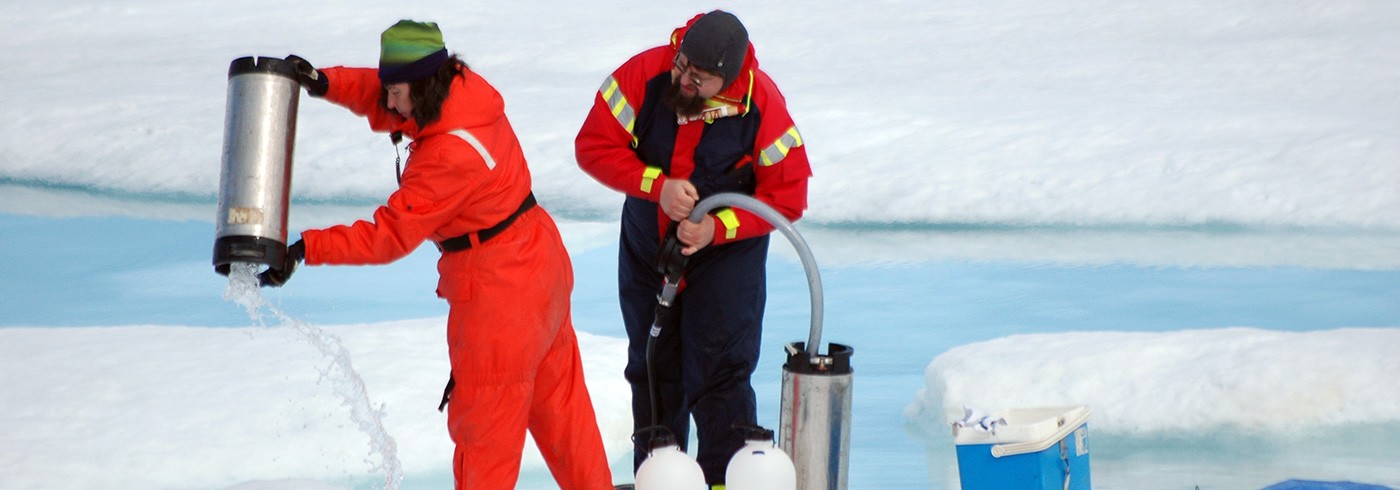Microbial loop in the Arctic Ocean
21 August 2005 - 18 September 2005
Concentrations (mg m-3) of chlorophyll a pigment and phaeophytine pigment at the station 07 September (Lomonosov Ridge).
The aim
The arctic pelagic ecosystem has historically been used as an example of the short and simple classical food chain. During the last decades the importance of the microbial food web (loop) has been documented for several arctic ecosystems (Rivkin et al. 1991, Nielsen and Hansen 1995, Hansen et al., 1996, Nielsen and Hansen, 1999). The microbial loop is known as the pathway for dissolved organic matter (DOM) through the bacterial and microzooplankton communities to higher trophic levels. This pathway is considered important for carbon and nitrogen transport in the pelagic environment (Azam et al., 1983). Oceanic DOM represents one of the largest active reservoirs of organic carbon on earth (Hedges, 1992) and is important for understanding global carbon cycles and changes in the concentration of atmospheric carbon dioxide, the most critical greenhouse gas on our planet (Nagata, 2000). In the open ocean, accumulation of DOM is ultimately due to the uncoupling of biological production and consumption processes. The dominant oxidizers of marine DOM are heterotrophic bacterioplankton. Thus factors that prevent rapid microbial utilization of “freshly produced” DOM result in its accumulation (Carlson, 2002). Thingstad et al. (1997) proposed a hypothesis called the “malfunctioning microbial loop”. This hypothesis proposes that competition for limiting nutrient and grazing pressure reduce bacterioplankton growth rate, biomass and carbon demand to levels that allow accumulation of biodegradable dissolved organic carbon (DOC) during biologically productive seasons. Low temperatures have also been suggested as a mechanism that inhibits bacterial growth and may foster DOM accumulation (Carlson, 2002). From studies in the Arctic Ocean it has been shown that even though high bacteria activity was measured there were also high concentrations of DOM and DOC. These results raise questions about the general relationships among primary producers, DOM fluxes and concentrations and bacterial activity in perennially cold waters (Rich et al., 1997).
The aim of this study was to investigate the microbial loop in the Arctic Ocean and how the consumption of dissolved organic carbon is regulated by the bacterial growth and also their regulation mechanisms such as grazing from heterotrophic nanoflagellates. We also aimed to determine basic biological parameters that can act as a background data for future scientific work in an area with little data available.
The fieldwork
The main work was concentrated on the water samples from the rosette. Water samples were taken from 5–8 depths from the top 200 meters and analysed according to table 1. At three stations experiments were performed with water from the productive zone to describe the regulation mechanisms of the bacterial community. In addition 4–6 different types of samples from 9 ice stations were analysed according to table 2.

Suspended profile stations where the following samples were taken: Chlorophyll a and phaeophytine (Chl), Biogenic silica (BSi), Particulate carbon and nitrogen (C/N), Bacteria biomass (BaB), bacteria production (BaP), phytoplankton fixation (Phyto), staining of nanoflagellates with DAPI (Da), zooplankton samples (Zoo) and Experiment (Exp).
Preliminary results
Most of the samples taken on the expedition have not yet been analysed. Available data are Chlorophyll a concentrations, which were analysed onboard icebreaker Oden. The results indicate a general low biomass across the Arctic Ocean; see figure 1 as an example. It is important to remember that low biomass does not mean low production. The profiles show reduced nutrients in the surface waters at some stations and indicate that primary production has been going on. Also the results show that phaeophytine concentrations were higher than chlorophyll a concentrations at most stations and depths. This can indicate that secondary production was high and explain why the biomass was not higher. The zooplankton samples show that there were copepods and some jelly fish present. Later analyses of phytoplankton, nanoflagellates and ciliates will show the status of the phytoplankton and potential microzooplankton grazers.


